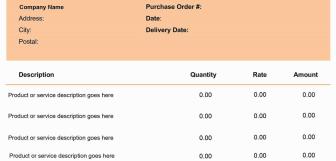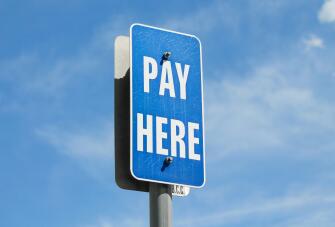What is a purchase order? Learn how it works in this guide
As an owner of a small business, tracking your inventory and ordering supplies and goods for your business may not always be your favorite task. However, it’s absolutely essential for the success of your retail or hospitality business.
Purchase orders (sometimes shortened to PO) are absolutely crucial for a well-managed purchasing process. Sadly though, many business owners don't really understand what purchase orders are or how they work.
So, in this complete guide we're giving you all the necessary details you need to better understand the purchase order process. We'll answer questions like:
- What is PO?
- How do they work?
- What do I need to include in a purchase order?
- What's the difference between an invoice and a purchase order?
- And more!
Let's get started!
Purchase order definition
A purchase order is a legally binding document produced by a buyer and sent to a seller. Similar to your “cart” on an e-commerce website, a purchase order is basically a list of goods and services you want to buy. It mentions the order details (so things like the amount and types of products), payment terms, and delivery information.
You might have heard of the term purchase requisition. This is different to a purchase order (and we'll explain why later on in this guide). A purchase order is basically a legally binding contract between a buyer and a seller. By submitting a purchase order, the buyer is essentially committing to the buying process for the agreed upon price. The order details are filled out before the buyer gets their bill, meaning a purchase order gives the seller insurance against the buyer not paying.
Elements to include in a PO template
Creating a purchase order form is really simple once you know what to include. There are a lot of online templates you can find but if you're wanting to just make one yourself on a Word or Excel document, here's what you’ll need to include:
- An issue date
- Products needed and the amount
- The details of the product, including SKU numbers, brand names, and model numbers
- The price per unit
- Delivery date
- PO number
- Business information including the shipping address, billing address, name of the company, and contact information
- Payment terms, like “paid upon delivery” or specific payment date options
Benefits of using a purchase order for your business
Now that you have a decent understanding of what a PO is, let's talk about why they're good for business. Here's some of the tremendous benefits they bring:
- Stops duplicate orders from happening: One of the most important benefits of purchase order creation is that it helps to prevent you from making duplicate orders. Say you're running a busy bakery and you need to order lots of different ingredients. Without a clear system, it’s easy to accidentally place the same order twice. That's a lot of unwanted flour, sugar and eggs that can result in overstocking, wasted money, and storage problems. By using purchase orders, every order gets a unique number and is recorded in an electronic purchase order system. This makes it easy to track what’s been ordered and from whom. Before placing a new order, you can quickly check the system to see if a similar order is already in progress.
- Keeps track of incoming orders: Another great thing about purchase orders is they help you keep track of what's coming in. When you run a business, especially one that has a ton of inventory, it's important to know what to expect and when. Purchase orders make this simple. Each PO lists what you ordered, how much, and when it should arrive. This info gets logged into your point of sale (POS) systems, giving you a clear picture of all incoming deliveries. When a shipment shows up, you can quickly check it against the PO to make sure everything’s correct. This way, you stay on top of your inventory, avoid shortages, and plan better for the future.
- Serves as a legal document: Because it’s a formal document, it provides legal protection for both the buyer and the supplier. If there’s ever a disagreement about the order, like a delivery issue or a pricing dispute, the PO can be referenced to resolve the problem. It acts as proof of what was agreed upon and helps ensure that both parties hold up their end of the deal. This legal backing gives you peace of mind and adds an extra layer of security to your business transactions.
Different types of purchase orders
Now that you know what a PO is and why it's great, let's get onto the different types of purchase orders you can create:
What is a standing purchase order
Buyers can also create special orders. These are for really large shipments or repeat / recurring purchases. A standing purchase order allows a buyer to purchase the same products again and again using the same PO number. Buyers can also create special orders. These are for really large shipments or repeat / recurring purchases.
What is a blanket purchase order
A blanket purchase order is an agreement between both the buyer and the seller for multiple deliveries over an agreed-upon period of time for a agreed-upon price. Blanket purchase orders are usually used between companies that have a strong working relationship and they sometimes come with special discounts or other incentives.
Note: You can get both of these purchase orders, electronic purchase orders or digital purchase orders by using electronic procurement systems. These systems streamline the purchasing process, ensuring efficiency and accuracy.
How do purchase orders work?
Purchase orders are usually used by companies purchasing goods or services in large quantities. For example, a retail store may need to buy several types of clothing (like dresses, tops, trousers etc) from a supplier, and order lots of styles of each type. Here’s the purchase order process you'd use to get your goods:
The business owner creates a purchase requistion
It all starts when the business owner or manager spots a need for certain goods or services. They jot down what they need, how much, and any specific details in a purchase requisition. This gets sent for approval within the company. Once it’s approved, it justifies why the purchase is needed and kicks off the buying process. The approved purchase requisition then heads over to the procurement team to create the official purchase order.
Buyer creates a purchase order
The procurement team takes the approved requisition and turns it into a purchase order. This PO lists all the nitty-gritty details: what’s being bought, how much, the price, delivery dates, payment terms, and anything else important. It gets a unique number for easy tracking. The buyer double-checks everything to make sure it’s correct and matches the requisition. Then, they send the PO off to the chosen supplier.
Supplier reviews the PO requirements
The supplier gets the purchase order and checks it out to see if they can meet the buyer’s needs. They confirm they have the items in stock, agree on the quantities and prices, and can meet the delivery schedule. If everything looks good, they sign it and send back a confirmation. Sometimes, there might be a bit of back-and-forth if they need to negotiate terms. This step makes sure both sides are on the same page before moving forward.
Buyer records the purchase order
Once the supplier confirms the PO, the buyer logs it into their POS system. They enter all the details like the PO number, what’s being bought, quantities, prices, supplier info, and expected delivery dates. Keeping track of this info is key for inventory management, managing budgets, and making sure everything gets delivered as expected. It also helps keep communication clear between the buyer and supplier throughout the process.
Payment processing services made simple
Take integrated payments at one fixed rate, with no hidden fees - anywhere, any time.
Difference between a purchase order and an invoice
A purchase order (PO) and an invoice might seem similar because they both deal with buying and selling goods or services, but believe it or not, they're different things that serve different purposes.
A buyer will create a purchase order, not a seller. It’s a document that tells the supplier exactly what you want to buy meaning it’s basically a request or an order for goods or services, and it helps both the buyer and supplier keep track of what’s been ordered.
Now, on the other hand, you've got an invoice. This is created by the supplier after the goods or services have been delivered. Now this is a bill that the supplier sends out, asking for the payment. The invoice will have things like: details about what was provided, the total cost, payment terms, and due dates on it.
So, while the purchase order starts the buying process by requesting items, the invoice closes the loop by requesting payment for those items.
Manage the purchase order process efficiently with Epos Now
Managing purchase orders efficiently is key to keeping your business running smoothly, and Epos Now's POS software makes it easy. Here’s how you can do it:
First, log into your Back Office from the Front Till by clicking the three lines in the top left and selecting Admin > Back Office. Once you're in, go to "MANAGE," then "Stock Control," and click on "Purchase Orders."
To add a new purchase order, click "ADD PURCHASE ORDER" in the top right corner. Enter the expected delivery date by typing it in or using the calendar icon. Choose the delivery location and the staff member creating the order from the dropdown menus. This ensures everything is tracked properly.
Next, select your suppliers. Use the search bar to find specific ones and check the "Show all suppliers and non-tracked stock" box to display all products. Click "SHOW PRODUCTS" next to the supplier to see what they offer. Adjust the quantities with the + and - buttons and update the cost per item if needed. The system will auto-fill the cost if it’s already set.
Once you’ve added everything you need, you have a few options:
- Generate a stock report to see your inventory levels.
- Save the order as a draft to finish later.
- Generate the order and email it to your suppliers.
- Just generate the order in your Back Office.
After generating the order, double-check the details on the Purchase Order Details page. If everything looks good, click "DONE."
With Epos Now, your stock levels are updated automatically, which means less manual work and fewer mistakes. This streamlined process keeps your inventory in check, helps maintain good relationships with suppliers, and makes sure your business stays on top of its game. Plus, you can integrate accounting software like QuickBooks and Sage directly into your POS system. This integration helps you manage your finances effortlessly, syncing your purchase orders and invoices with your accounting software for a smooth, hassle-free operation.
Check out our purchase order support page to learn more about how to:
- Create a purchase order on an Epos Now system
- Receive a purchase order on an Epos Now system
- Cancel a purchase order on an Epos Now system
Frequently asked questions about purchase orders
- Why would your business need to use a purchase order?
-
Using a purchase order keeps everything organized. It clearly shows what you're ordering, from whom, and at what price. This helps avoid mistakes and makes it easy to track your orders. It also prevents duplicate orders and helps manage your inventory better. Plus, it acts as a legal document if there’s ever a dispute. So, using purchase orders streamlines communication with your suppliers and helps keep your business running smoothly and efficiently.
- What is the disadvantage of a purchase order?
-
The main downside of using purchase orders is they can be a bit of a hassle to manage, especially for small businesses. Creating, reviewing, and approving each order takes time, which can slow things down. If you’re placing lots of small orders, the paperwork can really pile up. Keeping everything organized can also require extra effort or software. Despite these challenges, the benefits often outweigh the drawbacks, helping to prevent errors and keep things clear.
- How secure is a purchase order?
-
Purchase orders are pretty secure since they’re formal documents that detail the agreed terms between buyer and supplier. This helps protect both sides if there’s a dispute. The details like items ordered, prices, quantities, and delivery terms are all laid out clearly. While they’re not foolproof, they do add a layer of security. Using digital systems can make them even more secure with access controls and backups. So, while not perfect, purchase orders do a good job of keeping your transactions safe.
- What is the next step after a purchase order?
-
After you send a purchase order, the supplier reviews and confirms it. They check the details to make sure they can fulfil the order. Once confirmed, they prepare and ship the goods or provide the services. On your end, you should record the PO in your system to track its status. When the goods arrive, you’ll match them against the PO to make sure everything’s correct. Finally, the supplier will send an invoice, and you’ll process the payment according to the agreed terms.




